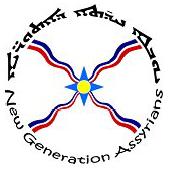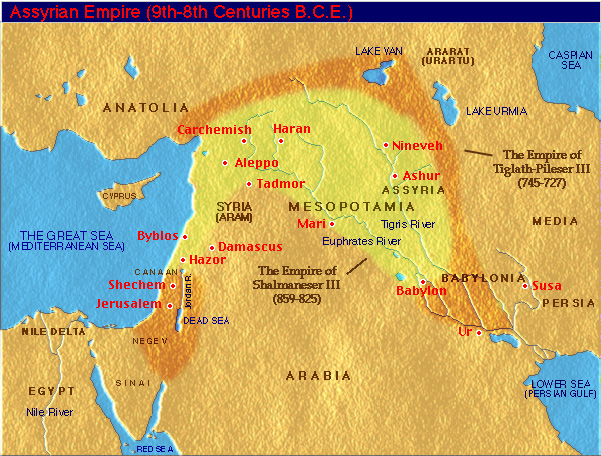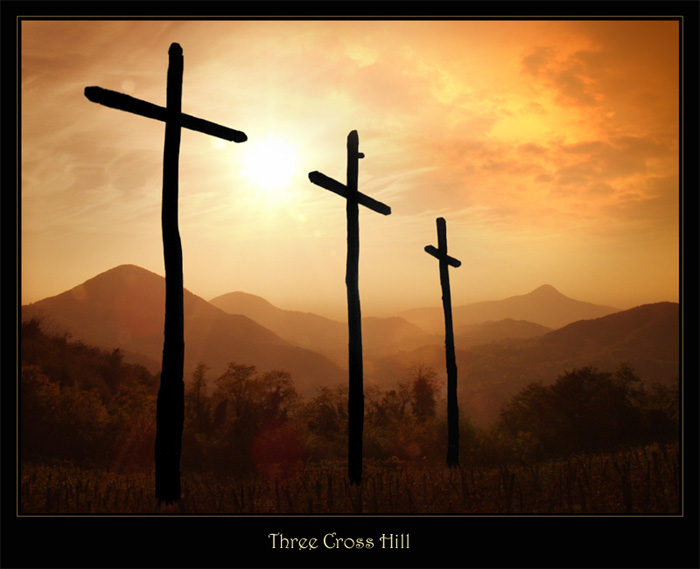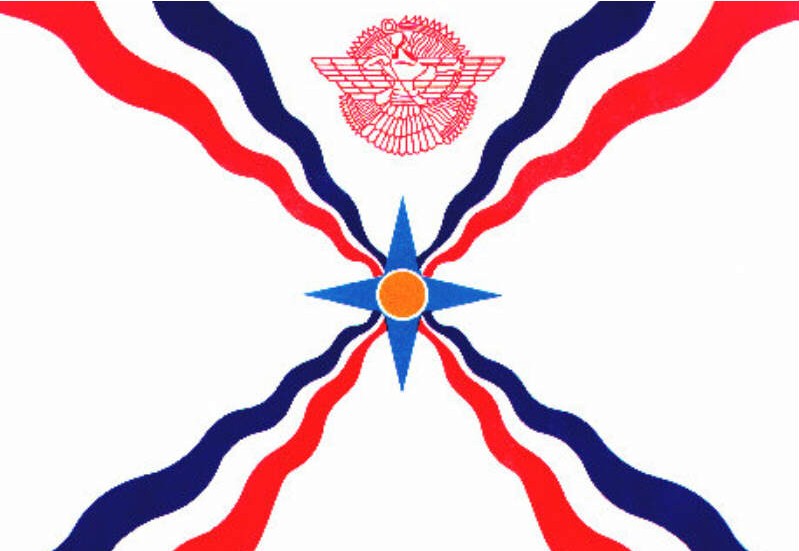
Assyrian History
![]()

![]()
Assyrian Geography

Assyria is located in north Mesopotamia and spans four countries: In Syria it extends west to the Euphrates river; in Turkey it extends north to Harran, Edessa, Diyarbakir, and Lake Van; in Iran it extends east to Lake Urmi, and in Iraq it extends to about 100 miles south of Kirkuk. This is the Assyrian heartland, from which so much of the ancient Near East came to be controlled.
Two great rivers run through Assyria, the Tigris and the Euhprates, and many lesser ones, the most important of which being the Upper Zab and Lower Zab, both tributaries to the Tigris. Strategically surrounding the Tigris and the two Zabs are the Assyrian cities of Nineveh, Ashur, Arbel, Nimrod and Arrapkha.
To the north and east of Assyria lie the Taurus and Zagros mountains. To the west and south lies a great, low limestone plateau. At the southern end of Assyria the gravel plains give way to alluvium deposited by the Tigris, and farther south there is insufficient rainfall for agriculture without irrigation. These two features create a geogrpahical boundary between Assyria and the neighboring land to the south.
To the south of Baghdad lies Babylon. There is a stark geographical distinction between Babylonia and Assyria. To quote Saggs,
A journey in spring from Baghdad, the capital of modern Iraq and within the Area of Ancient Babylonia, to Mosul [Nineveh], which is near several old Assyrian capitals, takes the traveller into what is manifestly a different country. In the region of Baghdad and southwards the predominant vegetation is palm trees. . .The terrain is flat to the horizon, and for most of the year its sun-parched earth is arid and dead wherever irrigation ditches do not reach. Approaching Mosul [Nineveh] the traveller finds a striking change. The flat terrrain gives way to undulating plains, in spring green with pasturage or cereal crop and gay and scented with flowers and clover. The rolling plains are cut with wadis, aflow after spring rains, with higher ranges of hills on the horizon. The traveller has reached Assyria.
The Assyrian land is rich and fertile, with growing fields found in every region. Two large areas comprise the Assyrian breadbasket: the Arbel plain and the Nineveh plain. To this day these areas remain critical crop producers. This is from where Assyria derived her strength, as it could feed a large population of professionals and craftsman, which allowed it to expand and advance the art of civilization.

The Assyrian Alphbet

Assyrians have used two languages throughout their history: ancient Assyrian (Akkadian), and Modern Assyrian (neo-syriac). Akkadian was written with the cuneiform writing system, on clay tablets, and was in use from the beginning to about 750 B.C.. By 750 B.C., a new way of writing, on parchment, leather, or papyrus, was developed, and the people who brought this method of writing with them, the Arameans, would eventually see their language, Aramaic, supplant Ancient Assyrian because of the technological breakthrough in writing. Aramaic was made the second official language of the Assyrian empire in 752 B.C. Although Assyrians switched to Aramaic, it was not wholesale transplantation. The brand of Aramaic that Assyrians spoke was, and is, heavily infused with Akkadian words, so much so that scholars refer to it as Assyrian Aramaic.

Assyrians have practiced two religions throughout their history: Ashurism and Christianity. Ashurism was, of course, the first religion of the Assyrians. The very word Assyrian, in its Latin form, derives from the name of Ashur, the Assyrian god. Assyrians continued to practice Ashurism until 256 A.D, although by that time, most Assyrians had accepted Christianity. Indeed, Assyrians were the first nation to accept Christianity, and the Assyrian Church was founded in 33 A.D. by Thomas, Bortholemew and Thaddeus.

The Assyrian flag consists of a golden circle at the center which represents the sun. By its exploding and leaping flames it generates heat and light to sustain the earth and all it's living things. The four pointed star surrounding the sun symbolizes the land, its light blue color means tranquility. The wavy stripes extending from the center to the four corners of the flag are the three major rivers of our homeland, namely Tigris, Euphrates and Zawa. The dark blue represents Euphrates which stands for the Assyrian word Prat meaning Per-U-Ta = abundance. The red stripes represent Tigris, it's blood red hue stands for courage, glory and pride. The white lines in between the two great rivers is Zawa, it's white color stands tranquility and peace. Some interpret the red, white and blue stripes as the highways that will take the scattered Assyrians back to their ancestral homeland. Above the blue star is the image of the Assyrian god Assur, who is guarding the country the flag and the nation it represents. On top of the flagstaff is the standard of King Sargon I, who established the first Assyrian empire. During the ancient times this insignia stood by the king's side to let everyone know his whereabouts.
Powered by WB4.DE, dem gratis Homepage Provider
Verantwortlich für den Inhalt dieser Seite ist ausschließlich
der Autor dieser Homepage. Mail an den Autor